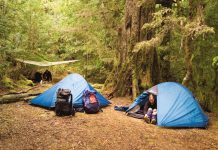 While it is unlikely that anyone camping in the continental United States would see a lion or a tiger, it is perfectly possible to run into a bear.
While it is unlikely that anyone camping in the continental United States would see a lion or a tiger, it is perfectly possible to run into a bear.
It is important to take precautions for the safety of humans and bears alike.
Bears are found in most areas of North America and are even becoming a nuisance in populated areas outside of cities on the east coast. Bears are not afraid of people.
Before setting up the camp, check the area for discarded food or obvious bear signs like tracks, scat or scratching on trees. Do not set up camp if these conditions are present and also, avoid camping near streams.
Bears are attracted by scent thus use fragrance-free grooming products and do not use a bug repellent with citronella. Bears love the smell of citronella.
Set up your tents in a line or semi-circle near your food preparation area. Keep all food, including snacks like candy bars, in bear proof containers and well away from your camping tent. Garbage should also be kept in bear proof lockers at least one hundred yards from your tent.
Personal grooming products like toothpaste and deodorant should be kept in your car. Cooking should be done on a portable grill at least one hundred yards away from your sleeping area. In addition, put the clothes you wear for cooking with the food.
When breaking camp, remember to pack everything that you brought in including garbage and food scraps. Don’t spoil the site for the next camper by leaving anything that would attract bears.









